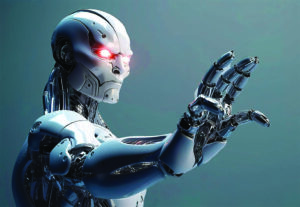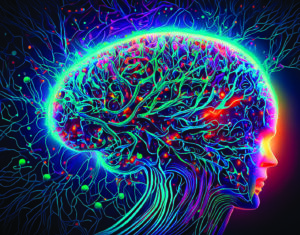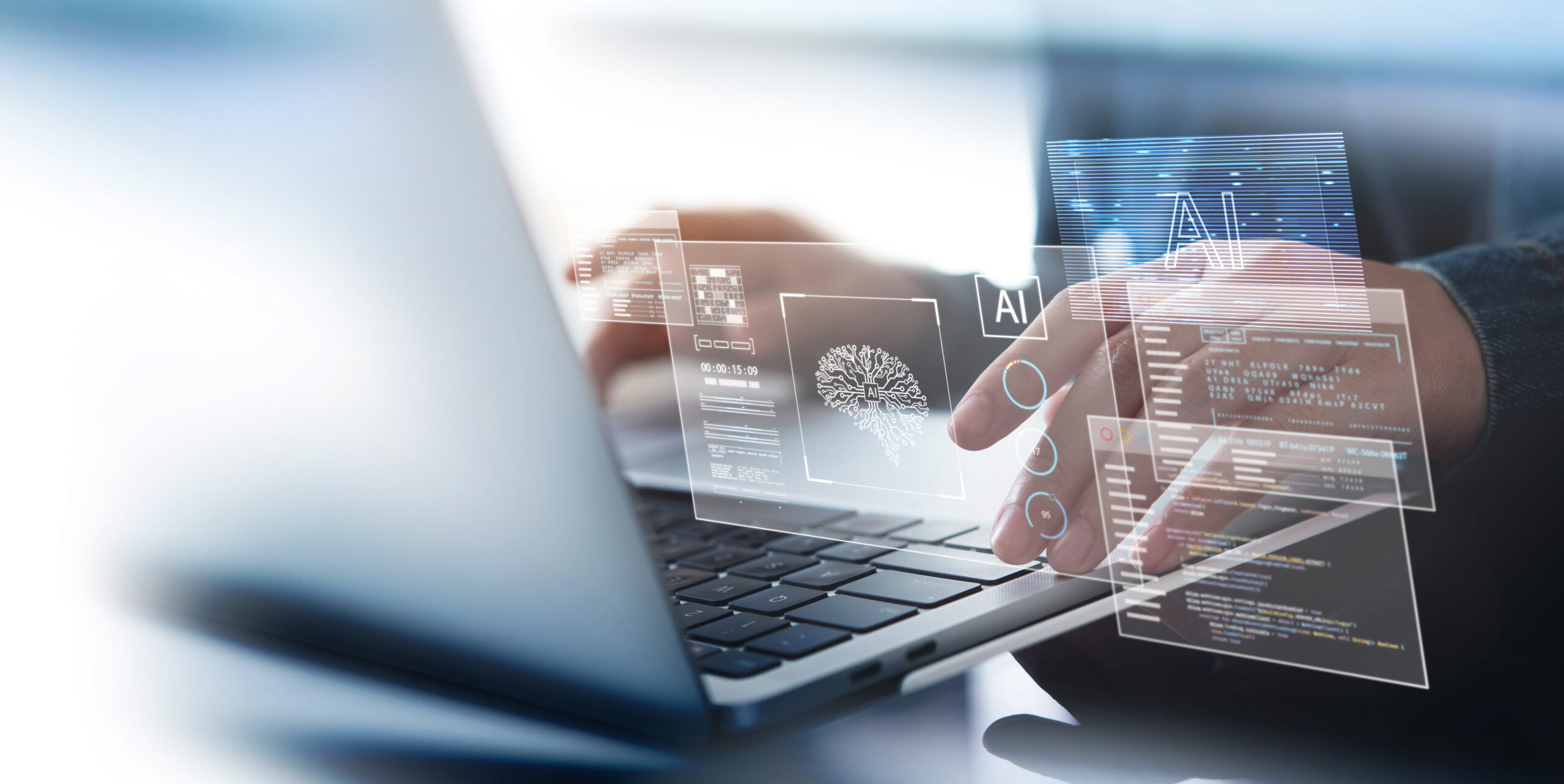Artificial intelligence (AI) is the big topic of the moment. Aside from the hundreds of images, videos, and text created by AI that we see daily, there are dozens of articles about how we can benefit and profit from it, and how it can be regulated and controlled. Occasionally, self-searching questions are asked. Is AI ethical? Are we headed to a future ruled by machine gods? (Fig. 1)

These are extraordinary times. AI is yet another technological upheaval, similar to the 1980s and 1990s when the personal computer landed on our desks, or industrial revolution of the 19th century when mass production provided goods to a growing population. It’s even as significant as the invention of movable type press in the 14th century when books were printed and distributed, and the common citizen became literate.
AI is the next phase of technological evolution. Here we are again at the crossroads that will profoundly affect how we work, communicate, and live.
A brief history of AI
The evolution of artificial intelligence spans several decades with an ongoing series of developments, breakthroughs, and challenges. The history of AI is characterized by periods of rapid progress and frustrating stagnation. Despite the hills and valleys of its evolution, AI has developed into a multidisciplinary field with profound implications for society, technology, and the future of humanity.
Ancient times
The idea of creating artificial beings with human-like intelligence is an early concept in the human imagination with myths and legends featuring automatons and mechanical beings. Even Greek philosophers such as Aristotle contemplated the concept of automated beings who were smarter and stronger than mere mortals. One prime example in Greek mythology is Talos, a giant made from bronze by Hephaestus, god of the forge, that guarded the entrance of Crete. (Fig. 2)
Jump ahead many centuries to the 1950s. Alan Turing, the pioneering British mathematician, logician, cryptanalyst, and computer scientist proposed that a machine could potentially perform intelligent behavior indistinguishable from that of a human. (Fig. 3)
AI is born
The official birth of AI as a field is often attributed to the Dartmouth Conference in 1956, where the term artificial intelligence was coined by John McCarthy and other researchers. Early AI pioneers, including McCarthy, laid the groundwork for AI by developing early computational models and symbolic reasoning systems.
During the 1950s and 1960s researchers developed early AI programs including the Logic Theorist and the General Problem Solver. These programs relied on algorithms that focused on problem-solving and symbolic reasoning.
The AI winter
Despite initial enthusiasm, progress in AI faced significant challenges and criticisms during the 1970s and 1980s. This period, known as the AI Winter, when interest and funding declined due to unmet expectations. The limited power of computer processors and relatively small databases, of data also contributed the stagnation of research.
During the AI Winter there was some research that focused more on Expert Systems. These are rule-based systems designed to emulate the decision-making processes of human experts in specific domains. Knowledge Representation also became a crucial area of study, exploring how to encode and manipulate knowledge in computers in a way that facilitates reasoning and problem-solving.
In the 1980s and 1990s Machine Learning emerged as a dominant paradigm within AI. Researchers experimented with algorithms and techniques that enable computers to learn from data and improve performance over time. The development of Neural Networks, inspired by the structure and function of the human brain, experienced a resurgence in research and development during this period leading to breakthroughs in areas such as pattern and speech recognition. (Fig. 4)

AI resurgence
The 2000s witnessed a resurgence of interest and investment in AI. With advances in computational power and accessible big databases, new algorithmic innovations were developed. Deep Learning, a subfield of Machine Learning, focused on artificial neural networks with multiple paths and layers that has revolutionized AI in areas such as image recognition, language processing, and autonomous vehicles.
AI in a nutshell
AI systems access enormous amounts of data and utilize algorithms that simulate human-like reasoning. To put it a bit more simply, all this data harvesting, text, image, and video creation boils down to zeros and ones — binary code that the computer uses to process information. The data network however, has grown to an infinite size and is constantly changing. Algorithms have developed into sophisticated, complex formulas that replicate the functions of the human brain that research, recognize, organize, and isolate relevant data. Furthermore, computers have powerful coprocessors that can handle vast amounts of data.
Graphics
Artificial intelligence has transformed various aspects of design, production, and marketing of print and digital media. Specifically, AI has influenced the graphics industry by revolutionizing the way images are created.
Time & effort
First of all, AI helps designers create complex graphics more efficiently. AI-powered automated design processes, such as what was presented in Part 1 using the stand-alone app Firefly, enable automation of repetitive tasks. These tools use machine learning algorithms to generate designs, layouts, and visual elements based on user input and preferences called prompts. AI-driven design platforms assist in creating numerous graphic assets, saving time and effort for designers.
Image processing
AI algorithms, particularly those based on deep learning, have advanced image processing and enhancement techniques. AI-powered software can automatically adjust colors, improve sharpness, remove noise, and enhance details in images, making them more visually appealing. Graphic designers and photographers use these tools to enhance the quality of their images and create more compelling visual content.
Personalization
AI techniques enable personalized content creation based on user data and preferences. In the background, AI algorithms analyze user behavior, demographic information, and past interactions to tailor graphics and marketing materials to individual users. Personalized graphics, such as targeted advertisements, email campaigns, and social media content, enhance the viewer’s engagement.
Video & animation
AI technology has revolutionized visual effects and animation in the graphics and cinema industries. AI-powered software enables the creation of realistic CGI (computer-generated imagery), special effects, and animations for films, video games, virtual reality experiences, and multimedia productions. AI algorithms can simulate natural phenomena and generate lifelike characters. They also automate tedious animation tasks, reducing production time and costs.
While researching this article, I read that very recently, OpenAI, the company that created ChatGPT, an AI text generator, and Dall-E, an AI image generator, has announced a new system called Sora. Sora is a text-to-video generator that can potentially revolutionize how video content is created.
Project management
AI technologies optimize workflow processes and facilitate collaboration among graphic designers and creative teams. AI-driven project management tools streamline task assignments, scheduling, and resource allocation to improve efficiency and productivity. AI-powered collaboration platforms enable real-time feedback, version control, and remote collaboration on graphic design projects promoting creativity and innovation.
AI has transformed the graphics industry by enhancing creativity and efficiency. As AI technology continues to evolve, it will likely play an increasingly crucial role in shaping the future of graphic design, visual communication, and digital media.
AI abuses

Here’s the rub. AI has been abused in various ways, often reflecting the exploitation of its capabilities for unethical or malicious purposes. This is an image of an internet scam recently published on Facebook. (Fig. 5)
No! Taylor Swift is not giving away free $1,000 gift cards. The video of her announcing this fake windfall is entirely an AI construction. Just send $9.95 (handling and processing charges) and receive your $1,000 gift card. Yeah, right!
This is an example of manipulative content generation. AI can be used to generate fake content, including text, images, videos, and audio recordings. Malicious actors may create AI-generated content to spread misinformation, manipulate public opinion, or deceive individuals for financial gain or political motives.
Scary!
AI-powered chatbots and social media bots can be used for Automated Social Engineering attacks, such as phishing scams, identity theft, and fraudulent activities. These bots can impersonate individuals, organizations, or customer service representatives to deceive users into disclosing sensitive information or performing malicious actions.
Discrimination
AI algorithms can exhibit inherent biases in the data used to train them, leading to discriminatory outcomes or unfair treatment of certain individuals or groups. Biased AI systems may perpetuate existing societal inequalities, amplify stereotypes, or discriminate against marginalized communities in areas such as hiring, lending, criminal justice, and healthcare.
Privacy
AI technologies used for data analysis, surveillance, and tracking can pose significant risks to individual privacy and data protection. Malicious actors may exploit AI-powered surveillance systems, facial recognition technology, or data mining algorithms to invade privacy and conduct unauthorized surveillance or infringe upon individuals’ rights to privacy and anonymity.
Cyberattacks
AI can be weaponized to launch sophisticated cyberattacks generating malware, network intrusion, and data breaches. Adversarial machine learning techniques can be used to bypass security mechanisms, evade detection, or exploit vulnerabilities in AI systems. These attacks present serious cybersecurity threats to organizations, governments, and individuals.
Super scary!
The potential development of AI-powered autonomous weapons systems raises profound ethical and humanitarian concerns. Lethal autonomous robots to indiscriminately target civilians violates international laws of war and can escalate conflicts. The deployment of AI in military applications without adequate human oversight and accountability poses significant risks to global security and stability.
Countering abuse
Preventing the abuse of AI will require a comprehensive approach consisting of
ethical guidelines, a regulatory framework, transparency measures, and accountability mechanisms to mitigate the potential risks and promote the responsible use of AI. These parameters are currently not in place but are encouraged by AI providers and will hopefully be established soon.
The end…
I hope I’ve managed to present an unbiased overview of AI. To quote the linguist and social critic, Noam Chomsky, “The human mind is not, like ChatGPT and its likes, a statistical machine and greedy of hundreds of terabytes of data to obtain the most plausible answer to a conversation or the most likely to a scientific question.”
On the contrary … “the human mind is a surprisingly efficient and elegant system that operates on a finite amount of information.” Chomsky doesn’t try to damage correlations from the data but tries to create explanations. Let’s stop calling it Artificial Intelligence then and call it for what it is and makes!






